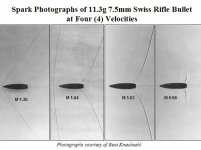I've heard various reports over the years about claims that certain bullet gun combinations are more accurate at longer ranges & that some recover accuracy once they become subsonic. I had not read or seen any theory to support this. But some random musing whilst working up load data in Quickload & having read some of Brian Litz ballistic info on transonic effects, gave me an idea. So I started looking for supporting Cone Theory info & found this, which has some input from Brian Litz, which covers shorter distances;- https://www.researchgate.net/publication/224927152_A_Coning_Theory_of_Bullet_Motions
Transonic flight info;- https://www.accurateshooter.com/ballistics/transonic-effects-on-bullet-stability-bc
My idea is this.
A long (ELD) bullet travels for a distance/time until its velocity enters the transonic speed range (circa 1340-1120fps @ sea level), it continues to lose velocity & ultimately falls below the speed of sound. Now during the transonic phase, the centre of pressure moves back along the bullet, causing it to loose some of its stability, but its still spinning well above the gyroscopic stabilty minimums, thus wants to continue straight if possible. But outside effects are having an impact.
Now I have experienced this effect from a short barrelled 308 pushing 155 Scenars @2800fps, out to 900yds very accurate, at 1000yds shotgun groups. But interestingly, further analysis shows not shotgun (as in random) but rather in a circular dispersion or cone if you like, around the edge of the Black target centre. Obviously the bullet was losing stability, but most people think of this as a 2 dimensional effect (pitch/yaw), which it is, but its happening anywhere around a circle centered on the bullet.
This got me thinking about those reports of bullets getting accurate again past the transonic zone. Bear with me here. So if a bullet is flying along & then starts to destabilise, it does so in a circular motion, it could initially pitch up/down or yaw left/right, but the effect is fairly constant, anywhere in a circle. So if the bullet does NOT fully destabilise & tumble, the gyroscopic effect of its spin will recenter it like in the Cone Theory above & it should start to come back to the center of the circle. Unfortunately I don't have access ranges long enough to test this, nor tools to display the info in a visual format. But imagine Brians epicyclic motion image below on a larger scale as in the circle is perhaps a few feet across. Bullet motion in side on 2D ---------<cone>---- , cone of instability widens, then corrects at subsonic speeds.
This is just a theory for discussion

Transonic flight info;- https://www.accurateshooter.com/ballistics/transonic-effects-on-bullet-stability-bc
My idea is this.
A long (ELD) bullet travels for a distance/time until its velocity enters the transonic speed range (circa 1340-1120fps @ sea level), it continues to lose velocity & ultimately falls below the speed of sound. Now during the transonic phase, the centre of pressure moves back along the bullet, causing it to loose some of its stability, but its still spinning well above the gyroscopic stabilty minimums, thus wants to continue straight if possible. But outside effects are having an impact.
Now I have experienced this effect from a short barrelled 308 pushing 155 Scenars @2800fps, out to 900yds very accurate, at 1000yds shotgun groups. But interestingly, further analysis shows not shotgun (as in random) but rather in a circular dispersion or cone if you like, around the edge of the Black target centre. Obviously the bullet was losing stability, but most people think of this as a 2 dimensional effect (pitch/yaw), which it is, but its happening anywhere around a circle centered on the bullet.
This got me thinking about those reports of bullets getting accurate again past the transonic zone. Bear with me here. So if a bullet is flying along & then starts to destabilise, it does so in a circular motion, it could initially pitch up/down or yaw left/right, but the effect is fairly constant, anywhere in a circle. So if the bullet does NOT fully destabilise & tumble, the gyroscopic effect of its spin will recenter it like in the Cone Theory above & it should start to come back to the center of the circle. Unfortunately I don't have access ranges long enough to test this, nor tools to display the info in a visual format. But imagine Brians epicyclic motion image below on a larger scale as in the circle is perhaps a few feet across. Bullet motion in side on 2D ---------<cone>---- , cone of instability widens, then corrects at subsonic speeds.
This is just a theory for discussion

Last edited:




